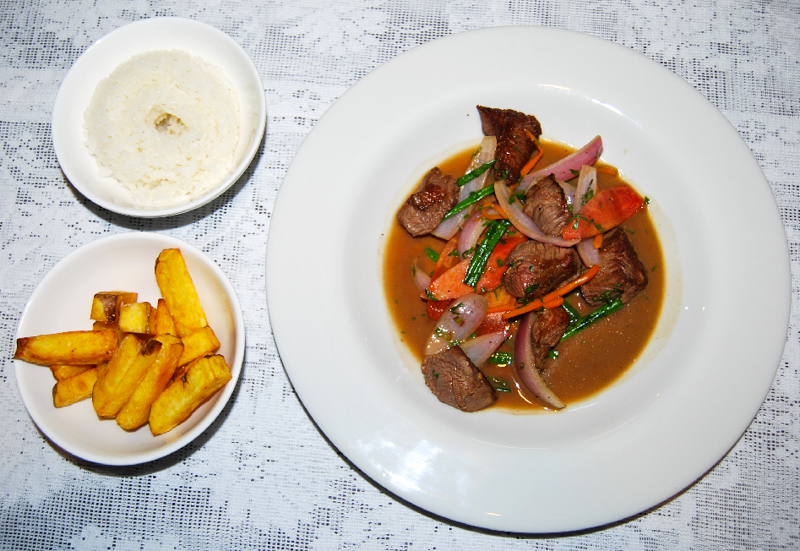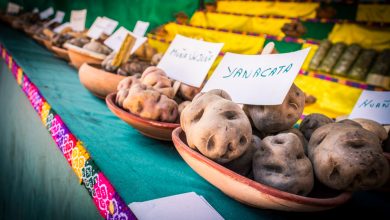Is Peruvian Cuisine Mestizo?

The rains delayed the flights to Cusco, they announce on the loudspeaker. I sit in Lima’s airport knowing I shall be departing when the rains permit.
Rain is a powerful force in Peru’s highlands, sometimes slow and gentle, and other times fierce; it tosses lightning and flooding waters with abandon. It is like those personless voices that announce so much of our life and control it.
While waiting, I want to write about another kind of powerful force, race. It slices and dices Peruvian society into smaller pieces, claiming people’s bodies and selves. It is cooked and presented even in food.
Since the Spanish came, Peruvians are forced into a race that was not their’s, Indians, while newcomers from Europe claimed a separate race. The parvenus soon divided themselves into Europeans and Creoles, those born in the new world. Because they came with African slaves, another schema of Blacks and their descendants also appeared.
The richness and subtleness with which these outsiders subdivided themselves and their children contrasted with the sparseness of Indian as a category, even if it covered the vast majority of the population and in it you found rulers and subjects, as well as people who spoke numerous languages and dialects and had many different ways of living and being.

You see this structure in food. Creole food is the national cuisine, comida criolla. It is “Peruvian food”, and as such is found throughout the country as well as being the face of the country presented in restaurants wherever Peruvians or those who love Peru have gone.
In this idea of Criollo is a strange play. Gaston Acurio captures it beautifully. He describes his quest to become a “cook”, read “celebrity chef”. He writes how for the people of upper middle or upper class Lima, those who could afford to pay top prices for good food and fine presentation, good cuisine was understood as French in the 80s and earlier. The idea of Europe, condensed in the master sauces and, as he writes, foie gras, was what they wanted.
To Acurio, this was strange, even though he was from this same class. In the streets and markets, as well as in the homes of more ordinary Peruvians, a different cuisine existed, the Creole. Though named after the children of the European invaders, it was born in Peru as African and Indian cooks created foods, using their memories and skills, as well as what they found. They fed themselves and opened businesses, feeding others in the streets and markets.
Masses of new immigrants came, Chinese, Japanese, Italians, Germans, and so on, seeking place in the hierarchical society of Perú’s coast. Their efforts to create meaningful food and claim identity and place added to the variety of Creole food, its saltados (stir fries), its green and red sauces for pastas, its tiraditos (sashimi in sauce), and its sausages. Not everything passed the filter of moving into the streets, markets, and homes and that process needs careful historical study.

Nevertheless, this diverse food fit with the mixing and blending process that Peru’s intellectuals seized on to argue for a political base for their nation and for different leaders than the traditional White Peruvians, even if the Individuals were part Black or Indian. Following the Mexicans, they celebrated the blend of different people and called them Mestizos, mixed. The Mestizo became the new Peruvian par excellence and his (yes, gendered) food made by women became the symbol of national identity. It became a symbol of codified “culture” that could be constrained, codified, branded, and sold.
It was not the ideal food of the leading classes. That was still European, i.e. French. Acurio picks up a problem.
He writes that his family, and I will add the upper middle and upper classes in general, did not cook for themselves, not even in their own homes. They tried to train their house staff. to make the food more European.
Gastón writes how Creole cuisine (comida criolla) started entering fine restaurants and people’s consciousness during the brutal civil war of the eighties and into the nineties and while democracy returned to the country. After the war, Peruvian elites sought new ways of building national identity and ways of disciplining and constraining the population to prevent a new class-war—read “race-based war”.
The apparent mixed-ness of this cuisine became important for this new Peru. It was something to celebrate. It became an ideology people could consume whenever or wherever they sat down for ceviche, fired rice (arroz chaufa), saltado, or later Pollo a la Brasa (rotisserie chicken)—a former elite food made available to the masses by industrial production and new techniques. Mestizo now rules—yet in it is a conflict and a contrast, in food and discipline.

That term breaks apart sometimes. It can include a different Mestizo who is not quite a Mestizo, a cholo. In the affirmation of this identity—cholo soy (I am a cholo) composed by Luís Abanto Morales—this racial and social category reintroduces the Indian. It claims a place for Indians in the constrained space of Mestizos. It embraces the category while subtly saying some are less native than others, even if it leaves outside as reference the mass of Indians as a kind of family and others.
In this we find gap that still cuts through Peruvian life and Peruvian cuisine.
The country’s majority is still indigenous, since saying Indian can seem insulting. They still eat foods that developed with the pyramids and the road system that brought all the country together along with neighboring countries, many of which used to be part of the political world that became Peru. I mean the Qhapaq Ñan, the royal highway system that the Spanish let fall into disuse as they built their Peru on top of the other, apparently.
The indigenous, is not just found in the ingredients at the heart of Peruvian food but in the ways food is put together.
Just one example, the famous causa. It involves native golden potatoes boiled, seasoned, and mashed, layered in a terrine with a non-native filling. The indigenous sandwiched the Creole, even if then people classify this whole as Creole. Strangely this complex play of invisibility, denial, and imposition comprises one of the relationships between native and invaders still played out not just in food but in so much of Peruvian life.
Mestizo, then as an idea, still gives power to a population that is more European in outlook, culture, and sometimes in genetics, while appropriating and making invisible the indigenous other than as background or base, that is legitimation of Mestizo rule. However, the indigenous is alive and well. It is not just a raw ingredient of Creole cuisine. It has its own life, whether that life is cholo or even Indian.
Again, the causa. You can see it as Creole giving the life of the dish, its value as bright and delicious filling, the protein of the dish. Or you can see the way the native, the potatoes and ajies (hot peppers) that season it, surround and contain the Creole as something important. It is a kind of Indian, or even cholo, schema for food.
One sees this intriguing, constraining, duality in much of Peruvian food, even if classified as Creole: another example, as the red and green pastas that all come with a pan-fried steak.
The idea of Mestizo as a definer of the cuisine, gives power to the urban, Spanish speaking people just below the European-ish elites, although, curiously, it is really the people from below, especially the Indians who define and make the food.
The Indian is there. It is simply as a list of native ingredients or dishes. It permeates Peruvian food in many ways, including the ways dishes are conceived and put together.
I think Mestizo should be turned on its head and the Indigenous should be looked at as that which weaves the strands of Peruvian cuisine together.
The Indian in richness, complexity, and diversity should be the interpretive frame for understanding Peruvian cuisine. The representation of this native relationship of insider and outsider, hierarchy of place and people, should ethnographer, journalists, historians and even just people who like to eat should pay attention to it.




